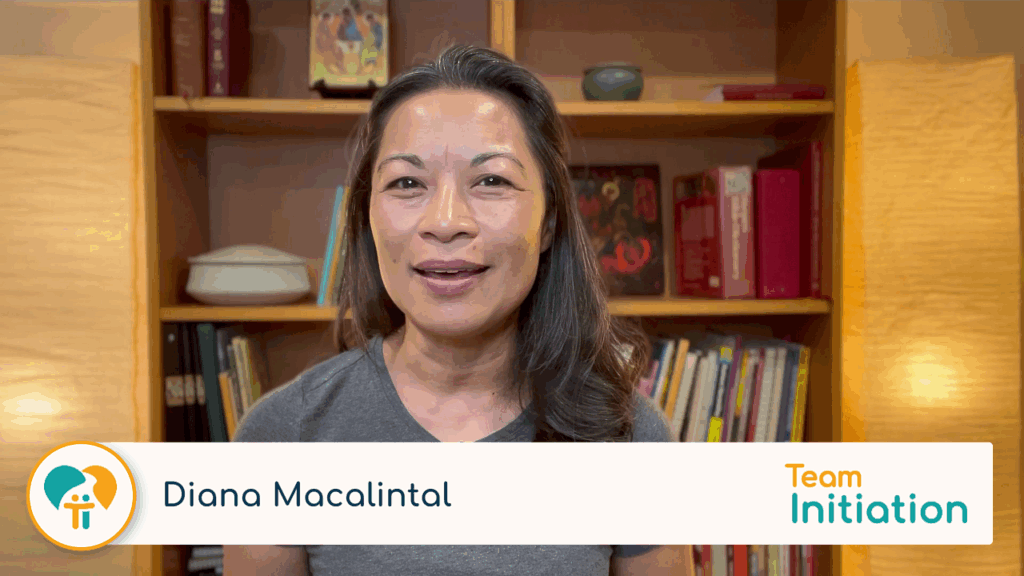
We frequently get requests for a good syllabus, textbook, or curriculum for RCIA. The question presumes a model of faith formation that is not found in the RCIA. When a seeker shows up at your door, let’s call her Jane, you cannot possibly know what her needs are based on the sound of her knock. Nor can a textbook publisher know. So it’s not possible to create a textbook or a curriculum for the RCIA.
Faith is not a body of abstract truths
Faith formation is not a classroom activity. It is a relationship experience. “The definitive aim of catechesis,” wrote Pope Saint John Paul II, “is to put people not only in touch but in communion, in intimacy, with Jesus Christ…. This teaching is not a body of abstract truths. It is the communication of the living mystery of God” (On Catechesis, 6, 7).
So how do we invite people into intimacy with Jesus Christ? How do we communicate the living mystery of God?
How did the first disciples teach?
Suppose your name is Philip and you are from the town of Bethsaida sometime in the early 30s. You have a friend, Nathanael, who doesn’t know Jesus. Your goal is to bring him into an intimate relationship with Jesus and to communicate to him the living mystery of God. What would you do?
What the actual Philip did was say, “We have found him about whom Moses in the law and also the prophets wrote, Jesus son of Joseph from Nazareth.”
Nathanael, being a skeptical guy, isn’t going to take your word for it. He wants proof. So you say to him, “Come and see” (see John 1:45-46).
What will seekers see?
Okay, so fast-forward to today. If you were going to introduce Jane to Jesus, and you said to her, “come and see,” where would you take her? To a textbook? To the Catechism? I would take her to places where Jesus is actually present. Mathew says that Jesus is present “where two or three are gathered” in his name (Mt 18:20). The Constitution on the Sacred Liturgy says Jesus is present in the liturgy, especially the consecrated bread and wine (body and blood), the priests, the Word, and in the community. Matthew also tells us that Jesus is present in the poor (Mt 25:40).
The parish is the plan
So if we were going to create a plan (a “curriculum”) for introducing Jane to Jesus, we would plan to take her to all the places in our parish where Christ is present. The RCIA summarizes all of these into four broad categories of parish life:
- Word
- Community
- Worship
- Service and witness (see RCIA 75)
As we get to know Jane and what her needs are, we will find various ways to act like Philip. Each time we discover a need, we will say something like, “We have found someone who can meet that need: Jesus son of Joseph from Nazareth.”
And when Jane is skeptical, we then say, “Come and see.”
And then we take her to Jesus, in the many manifestations of Word, Community, Worship, and Service that exist in our parish.
When is the seeker ready?
Once Jane has seen Jesus in all these manifestations and when she has, herself, begun to show some faith, begun to pray, started participating in the liturgy, started serving the poor and evangelizing others, and generally aligned her life with the spirit of Christ (see RCIA 78), she is ready to be fully initiated into Christ.
We wouldn’t say she is, at this point, a mature Christian. She is at an “initial” stage—initiation. Once she has reached the stage of initiation, then her postbaptismal, lifelong, ongoing formation begins. At that point, it might be appropriate to give her a textbook, a curriculum, or a syllabus. But catechesis for initiation is a simpler, yet profound introduction into the mystery of Christ. And the life of your parish is the plan for introducing her to Jesus.
What is your experience?
How does your parish manifest Christ? How have you used the life of your parish to introduce seekers to Jesus?


















Nick
I totally agree with your point of helping the inquirer and in particular catechumens to find Jesus in Word, Community, Worship and Witness.
I am currently reading “The Spiritual Meaning of the Liturgy, School of Prayer Source of Life” by Goffredo Boselli. ISBN 978-0-8146-4906-0. This book was recommended to me by Dr Carmel Pilcher RSJ, an extremely experienced Australian liturgist, author and university lecturer. I can in turn highly recommend it. Perhaps you might consider stocking it in the TeamRCIA bookstore.
Boselli regularly discusses in his book how the early fathers of the church understood and explained the paschal mystery through scripture and the liturgy. Incidentally this book has given me new ideas on how to explain what is going on in the Mass to an inquirer or catechumen.
As I am reading it I am forming the opinion that we have lost our way in RCIA. We have become too focused on faith formation using doctrinal catechesis, syllabus and RCIA curriculum. Consequently we have lost the vision and the methods of the early fathers of the church had for using the scriptures to explain and engross people in the liturgy and in turn to act out the liturgy and the paschal mystery of Christ in the remainder of the week. For the early fathers each Sunday became a reinvigoration of the paschal mystery through the scriptures to give energy and direction for the coming week. I am even more convinced that the dismissal session and its discussion is the key formation for catechumens.
I have found that putting effort into preparing and executing quality discussion in the dismissal session creates ideas and opportunity for the catechumens to witness over the coming week.
I am also now of the opinion that much of what is being covered by many RCIA textbooks, suggested syllabus and curriculum in their “catechesis” sessions does not belong in RCIA but rather forms some of the basis of ongoing faith and spiritual formation for the neophytes after their initiation. It may well be part of the RCIA mystagogia period or maybe part of an ongoing parish faith formation program that neophytes participate in.
Hi Max. Great insights, as always. Thanks for the tip on Boselli. Diana has read him, and he’s on my list of books to get to. We plan to put his book in the bookstore soon.
Nick
Max, thanks for your recommendation and also thank you for the point about adequate preparation for a dismissal session. I agree that the preparation of the facilitator is key. I think it is a big mistake to just “wing it” and have everyone talk about “what they got out of” the Liturgy of the Word. There are lots of good resources to help guide the leader.
Second, Nick, I love what you said about taking Jane to the places where Jesus is present. Yes, get out of the classroom! Sure, Jesus is present when we gather for catechesis, but Jesus is also present in SO many other places in the parish. Let’s take them there!
Thank you for this insight… I pray ever day that more in our ministry begin to see the grace of this approach. But let me add one more consideration… Textbooks make sense when everyone in the group is at the same level of experience and understanding. It assumes a common starting place that just isn’t present in the RCIA. You can use a textbook when you’re teaching a room full of 2nd graders about the Eucharist because, for the most part, they’re all at a common starting place. By the time an adult inquires into the RCIA, there’s no such thing as a common starting place. Each individual who comes to our doors has reached this point from a variety of paths and experiences, so their journey through the process has to be customized to answer their needs… and the only textbook that can do that is the life of the parish and the liturgy… in the Word, Community, Worship, and Service. Thanks!
this is what we need now, because of the social media issues: lets try to evolved with it, our RCIA team is 10 yrs behind by using the old text book curriculum style. I would like to get into the one to one with the neos and seekers as they come in. and show them the real presence of the liturgy at church and among others.